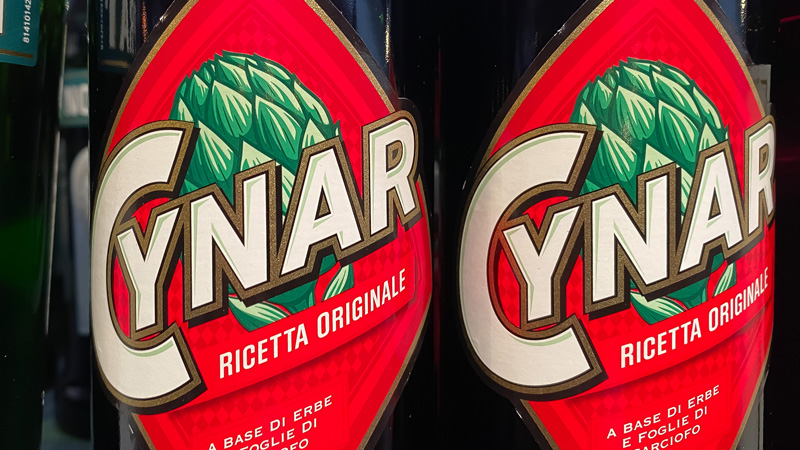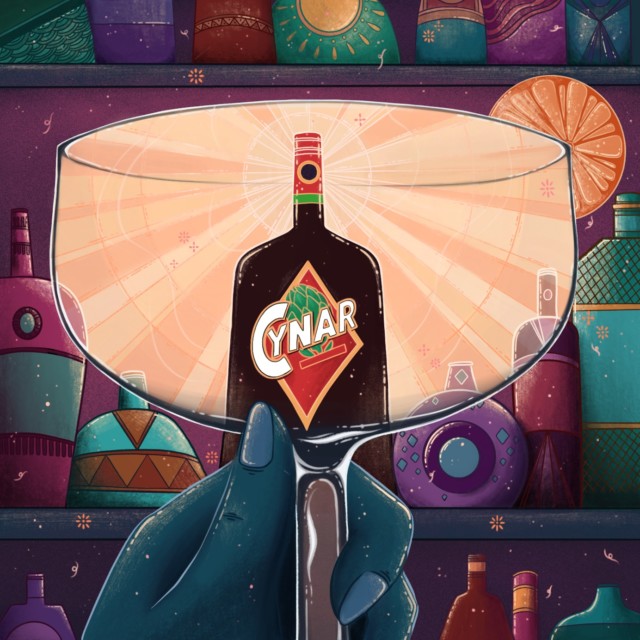Milk & Honey, the pioneering speakeasy opened by Sasha Petraske on Dec. 31, 1999, wasn’t known for its décor. Elegantly spartan, the Lower East Side bar’s most remarkable design feature was a large mural painted directly onto the brick wall to the left of the bar. It depicted the bold red-and-green label of Cynar, the Italian amaro that boasts artichoke as its only disclosed ingredient.
One might think that the mural was Petraske’s tribute to a beloved product. But no. He hated Cynar; he only admired the label. “I think Cynar is what they give you to drink in hell,” he once told me.
Petraske had many acolytes in the bartending field, but not many shared his opinion of Cynar. In fact, few spirits have been so thoroughly adopted by the cocktail bartender community over the past 20 years. Prior to the advent of the cocktail renaissance, Cynar’s recognition level in the United States was about as low as could be. It was little known outside of a few urban Italian-American enclaves.
Today, a bottle stands on the back bar of every respectable cocktail joint in the nation. It is a required ingredient in such modern classic cocktails as the Little Italy (rye, sweet vermouth, Cynar), Bitter Giuseppe (Cynar, sweet vermouth, lemon juice, orange bitters) and Trident (Cynar, aquavit, sherry). Other spirits were more famously cast in the role of mixologist darling during the early years of the cocktail revival — Fernet Branca, Chartreuse, St-Germain, and absinthe among them. Somehow Cynar never received the same level of press. But a strong argument can be made for it being the secret success story of the movement.
“There was a huge upswing in the use of Cynar in the early aughts,” recalls Toby Maloney. Maloney worked at Milk & Honey and Pegu Club, two of the most prominent of the early New York cocktail dens, before opening The Violet Hour in Chicago. “I heard that green Chartreuse had a 700 percent increase in the early aughts. It wouldn’t surprise me that Cynar had a similar growth spurt.”

When Maloney worked at Pegu Club, he remembered cases of Cynar in the liquor storage area. “Ordering multiple cases of things is usually reserved for base spirits,” he says, “not amari.” Pegu co-owner Julie Reiner recalls “blowing through” at least a case of Cynar a week. Much of that stock was used in the popular Little Italy cocktail, a Cynar-laced Manhattan riff invented by co-owner Audrey Saunders. (Cynar, which is owned by Gruppo Campari, an international liquor conglomerate whose products include Campari, Aperol, and Averna, declined several requests to discuss recent sales of the liqueur.)
When Maloney moved on to The Violet Hour in 2007, he doubled down on Cynar. He and his bartenders rolled out cocktail after cocktail that featured the amaro, such as the Art of Choke (Cynar, rum, Chartreuse, lime juice, mint, sugar) and Eeyore’s Requiem (Cynar, Campari, blanc vermouth, gin, Fernet Branca, orange bitters). In Maloney’s view, mixologists’ gravitation toward the product made perfect sense. “Once somebody had been turned onto Campari, Cynar was the next logical step,” he reasons. “Cynar also played so well with vermouth that it was a simple substitution for any cocktail that was a Manhattan, Vieux Carré, or Negroni riff.”
Kirk Estopinal was one of the early bartenders at The Violet Hour. He took what he had learned there back to his native New Orleans and, in 2009, applied it at Cure, the first important craft cocktail bar to open in that city. That same year, he and fellow bartender Maks Pazuniak collected a few dozen radical cocktails — in which they and selected colleagues took neglected liquors and treated them like base spirits — and published them as “Rogue Cocktails.” The influential cocktail book called for many unusual ingredients, but none more than Cynar, which was a component in more than a dozen drinks.
Estopinal saw the appeal of Cynar as twofold. “The first is its proof and profile made it an easy substitute for any fortified or aromatized wine,” he explains. Cynar’s ABV is a mere 16.5 percent, placing it in line with most vermouths. “This is the magic. You can sub it in a million classics and can be sure that the build is similar to the drink you started with.” Cynar’s second selling point was that it made for a perfect mystery date for curious customers.
“It was bitter and mysterious,” says Estopinal. “This is what we were all trying to do at the time — create customers with exotic flavors and first-time experiences. It has a lot of flavor, but it’s also not grossly bitter or lingering, and that makes it magical for the cocktail world and a great guest experience for someone that just wants to dip a toe in bitter things.”
Around the same time Cure and Violet Hour were toying with Cynar, Tonia Guffey, a bartender at Dram in Brooklyn, was making sure it earned a place as a “bartender’s handshake” — that is, a spirit shared between in-the-know bar professionals. In 2011, looking for a substitute for her beloved Fernet Branca, she whipped up the CIA, an equal-parts shot made of Cynar and applejack. (The name stands for “Cynar In Applejack.”) It quickly caught on.
“I don’t want to say I changed Cynar or anything,” said Guffey, whose work was also included in “Rogue Cocktails.” But she does think she and her fellow Cynar-friendly bartenders “definitely pushed it in the direction it deserved. I think that era of bartenders, 2009 to 2014, … changed a lot of the way the country drinks and what they drink.”
(Cynar’s rise in New York was not necessarily echoed on the West Coast until the 2010s. According to Dominic Venegas, a San Francisco bartender who was also a spirits buyer at John Walker & Co., an influential liquor store in that city, they didn’t go through a case of Cynar a month. “San Francisco is an amaro town, so we also were using Ramazotti, Averna, Nonino, Nardini, and, of course, Fernet,” says Venegas.)
Cynar has kept mum about sales numbers. But it was evident that the company saw what was happening when, in 2015, it launched the first line extension in the product’s history: Cynar 70. The higher-proof version of the liqueur was meant to cater to mixologists’ thirst for liquors with a bigger kick. The product, however, never caught on with bartenders the way the original had.
Today, Cynar is so ubiquitous that it’s easy to forget that it was almost invisible a generation ago. The ultimate irony of this reversal of fortune is that it might have been kicked off by the OG Cynar hater himself, Petraske. Every important bartender in the world passed through the original Milk & Honey at one point or another. Could they have interpreted his Cynar mural as an endorsement and taken that recommendation back to their own bars?
“I think that it had to have” had an influence, says Maloney. “I mean what better advertisement than an amazing bar putting up a mural for a product. If billboards work, that mural had the best placement on the planet.”
